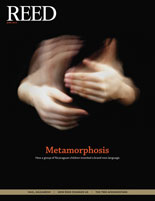
IRIS login | Reed College home Volume 92, No. 2: June 2013
Eliot Circular
School of Hard NOx
By Kate Schimel ’13
Julie Fry [chemistry 2008–] has received a $300,000 grant from the U.S. Environmental Protection Agency to study the effects of nitric oxide (NOx) in southeastern forests. She will be doing research and battling the heat in Alabama this summer, along with research assistant Hannah Allen ’14, who won the Mellon Environmental Studies Summer Experience Fellowship to fund her participation.
When natural emissions from forests interact with pollutants, including NOx and related chemicals, they form tiny atmospheric particles or aerosols. NOx comes from a variety of sources, including vehicle exhaust, coal-burning power plants, and large urban areas.
“We really don’t understand the chemistry of particle formation,” says Fry, whose project is part of a large scale collaborative effort known as the Southern Oxidant and Aerosol Study. Their research has implication for both climate change and human health. The aerosols, if inhaled over long periods of time, can cause cardiovascular and pulmonary disease. However, the particles can also create a light-blocking haze, which causes regional cooling.
Fry is particularly excited about the project’s opportunities for students. “It’s a great way to introduce students to the scientific community of atmospheric chemistry,” she says. “They get to connect with some of the big people in the field, to hear what the cutting-edge questions are.”
Senior Danielle Draper ’13 accompanied Fry on a previous project looking at similar chemistry in the pine forests of Colorado.
In addition, the EPA grant provides funds for a postdoctoral researcher, Ben Ayres, who joined Julie’s lab this spring.
“He’ll be a great resource in the lab for future thesis students,” says Julie. “I love working with thesis students, and I always wish I had more time. This allows someone else to act as a mentor, as well.”
Plus, she jokes, “he’s from Georgia, so he can help us with the humidity.”

LATEST COMMENTS
steve-jobs-1976 I knew Steve Jobs when he was on the second floor of Quincy. (Fall...
Utnapishtim - 2 weeks ago
Prof. Mason Drukman [political science 1964–70] This is gold, pure gold. God bless, Prof. Drukman.
puredog - 1 month ago
virginia-davis-1965 Such a good friend & compatriot in the day of Satyricon...
czarchasm - 4 months ago
John Peara Baba 1990 John died of a broken heart from losing his mom and then his...
kodachrome - 7 months ago
Carol Sawyer 1962 Who wrote this obit? I'm writing something about Carol Sawyer...
MsLaurie Pepper - 8 months ago
William W. Wissman MAT 1969 ...and THREE sisters. Sabra, the oldest, Mary, the middle, and...
riclf - 10 months ago